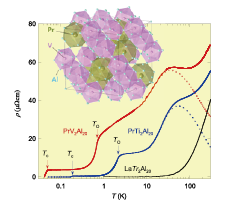Novel Superconductivity Mediated by Quantum Orbital Fluctuations
Nakatsuji Group
Superconductivity is a quantum macroscopic phenomenon where the electrons in solids form “Cooper pairs” at low temperatures, leading to a zero-resistance state. This has been studied extensively for basic science as well as for industrial applications. In the case of conventional superconductors, lattice vibrations (phonons) provide the “glue” among the electrons to form the Cooper pairs. On the other hand, in the case of magnetic materials such as the cuprate high-temperature superconductors, recent studies have revealed that fluctuations of the microscopic magnets inherent in electrons, namely “spin,” causes the formation of the Cooper pairs.

Fig. 1. (A) Schematic image of a quantum critical point that is realized by the suppression of magnetic ordering. There is a quantum phase transition from a magnetic (spin-ordered) state to a paramagnetic (disordered) state at the magnetic quantum critical point (QCP). Unconventional superconductivity mediated by spin fluctuations has been found at the vicinity of the quantum critical point. (B) Image of a quantum critical point realized by the suppression of orbital ordering (Spins in Fig. 1 (A) are changed to orbitals). It is a significant subject to reveal the physical properties in the vicinity of the orbital quantum critical point.

Fig. 2. The resistivity vs. temperature of PrV2Al20 and PrTi2Al20. TO and Tc represents the multipolar ordering and superconductivity transitions respectively. Tc is 0.05 K for V system and 0.2 K for Ti system. The inset shows the crystal structure of PrV2Al20.
Such superconductivity has been studied extensively especially in the 4f based intermetallics, where a lot of heavy fermion superconductors have been found in the vicinity of magnetic QCPs (Fig. 1(A)). Here, an interesting question is whether novel superconductivity arises at a QCP of orbital orderings due to orbital fluctuations of the f electrons or not (Fig. 1(B)). In order to study this, the material with purely orbital degrees of freedom is required. Besides, the material should be clean enough and the hybridization should be large. However, there has been no prototypical system that satisfies all these requirements.
On the other hand, recent studies have revealed that PrT2Al20(T = Ti, V) are the ideal systems to study the quantum criticality arising from orbital degrees of freedom [1]. Both systems have the nonmagnetic cubic Γ3 crystal electric field doublet. In addition, the hybridization is strong as is evident in many physical properties [1-3]. Significantly, both exhibit heavy fermion superconductivity inside the multipole ordered phases (Fig. 2) [2-4]. In particular, in the case of PrV2Al20, the effective mass is highly enhanced (m*/m0 ~ 140) even at ambient pressure, revealing even stronger hybridization in PrV2Al20 than in PrTi2Al20 [4]. Furthermore, the superconductivity emerges from a novel metallic state realized due to the strong fluctuations of the non-magnetic orbital degrees of freedom. This observation indicates the first realization of the novel superconductivity arising from the orbital fluctuations of the f electrons at ambient pressure.
The discovery of the new mechanism for the formation of Cooper pairs may open the new research field of the material science based on orbital degrees of freedom, and may lead to another breakthrough in the superconductivity research.
References
- [1] A. Sakai, and S. Nakatsuji, J. Phys. Soc. Jpn. 80, 063701 (2011).
- [2] A. Sakai, K. Kuga, and S. Nakatsuji, J. Phys. Soc. Jpn. 81, 083702 (2012).
- [3] K. Matsubayashi, T. Tanaka, A. Sakai, S. Nakatsuji, Y. Kubo, and Y. Uwatoko, Phys. Rev. Lett. 109, 187004 (2012).
- [4] M. Tsujimoto, Y. Matsumoto, T. Tomita, A. Sakai, and S. Nakatsuji, Phys. Rev. Lett. 113, 267001 (2014).
